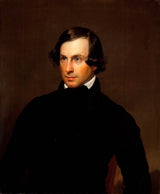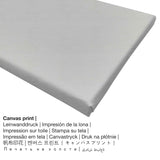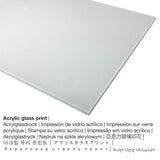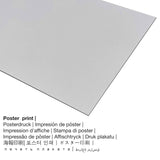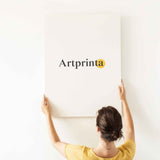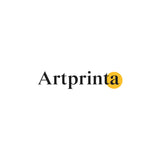Allen Smith, 1840 - Eserese nke Mr. Blodgett - ọmarịcha nka
Ụtụ gụnyere. Mbupu gbakọrọ na ndenye ọpụpụ.
Họrọ ihe kacha amasị gị
Anyị na-enye ụdị dị iche iche nha na ihe maka ngwaahịa ọ bụla. Nhọrọ ndị a dị maka n'otu n'otu:
- Mbipụta iko acrylic (nke nwere ezigbo mkpuchi iko): The acrylic glass print, which is sometimes labelled as a print on plexiglass, changes your selected original artwork into lovely wall décor. The major upside of a plexiglass art print is that contrasts and also small image details will be recognizeable due to the subtle gradation of the picture.
- Aluminom ihe eji eme ihe: This is a metal print made on aluminium dibond material with an impressive effect of depth. The non-reflective surface make a modern impression. The Direct Print on Aluminum Dibond is the perfect introduction to art prints on alu. For the Print On Aluminum Dibond, we print the chosen artwork onto the surface of the white-primed aluminum material. The bright & white parts of the artwork shimmer with a silk gloss but without any glare. The colors of the print are vivid and luminous in the highest definition, the fine details are clear and crisp. This direct UV print on Aluminum Dibond is the most popular entry-level product and is an extremely stylish way to showcase fine art prints, since it draws focus on the replica of the artwork.
- Poster (akwa akwa akwa): A poster is a UV printed canvas with a granular surface finish, which resembles the actual work of art. The print poster is optimally designed for putting the art copy using a special frame. Please keep in mind, that depending on the absolute size of the canvas poster print we add a white margin 2-6cm round about the painting to facilitate the framing.
- Mbipụta kanvas: A canvas direct print is a printed cotton canvas mounted on a wooden frame. Hanging a canvas print: Canvas Prints have the advantage of being low in weight, meaning that it is quite simple to hang your Canvas print without extra wall-mounts. Because of thatcanvas prints are suited for all kinds of walls.
Important information: We try all that we can to depict our art products as exact as possible and to illustrate them visually. Nonetheless, some pigments of the print products, as well as the printing can differ somehwat from the representation on the device's screen. Depending on your settings of your screen and the condition of the surface, colors might not be printed one hundret percent realistically. Bearing in mind that all art reproductions are printed and processed by hand, there may as well be minor differences in the motif's size and exact position.
(© - Ụlọ ihe ngosi nka nke Los Angeles County - Ebe ngosi nka nke Los Angeles County)
About the era
The art of the early Federal period did not greatly differ from that of the late colonial era. Portraits dominated the small field of painting. Victories on land and at sea in the War of 1812 brought the fledgling democracy greater confidence and new national pride. By 1829, when Andrew Jackson assumed the presidency, the foundations for an independent culture were securely laid. The philosopher-poet Ralph Waldo Emerson expressed the mood of the country in 1837: “our day of dependence, our long apprenticeship to the learning of other lands, draws to a close.” The following decades would bring a swell of artistic creativity, focused on native themes that extolled the seemingly limitless bounty of the New World. Portraiture, and to a lesser extent history painting, continued to occupy American artists, but increasing numbers turned to views of the local countryside and its inhabitants. Although the industrial revolution only began in the United States after the War of 1812, the following three decades witnessed economic changes, especially in the north, that significantly affected working conditions, family structure, and even religion. Paintings illustrated American virtues like ingenuity and industry as well as the pleasures of country life. The new taste for genre pictures—scenes of ordinary people involved in everyday activities—seemed ideally suited to the egalitarian attitude of the Jacksonian era. This period also saw the rise of the country’s first truly national school of landscape painting, ultimately known as the Hudson River school. Its earliest, best-known exponent, Thomas Cole, sometimes painted romantic literary subjects in European settings, but his dramatic depictions of the American wilderness helped spur the popularity of American views. As the country developed, paintings of uninhabited wilderness were replaced by views of farms, towns, and factories, but American artists retained their sense of awe about the land.
Nchịkọta nke eserese nwere aha Portrait of Mr. Blodgett
Nke a gafee 180 afọ nka nka kere site na nwoke American onye na-ese ihe Allen Smith. Ọ bụ nke Ụlọ ihe ngosi nka nke Los Angeles County mkpokọta. Site n'ikike nke: Ụlọ ihe ngosi nka nke Los Angeles County (www.lacma.org) (public domain license).Furthermore, the artwork has the following creditline: . Further, the alignment of the digital reproduction is in portrait format na oke nke 1: 1.2, nke pụtara na ogologo bụ 20% mkpụmkpụ karịa obosara.
Nkọwa gbasara ọrụ nka
| Aha eserese: | "Portrait of Mr. Blodgett" |
| nhazi ọkwa: | sere |
| Otu izugbe: | nkà nke oge a |
| Narị afọ nka: | 19th narị afọ |
| Afọ nka: | 1840 |
| Afọ nka: | karịa afọ 180 |
| Egosiputara na: | Ebe ngosi nka nke Los Angeles County |
| Ebe ebe ngosi nka: | Los Angeles, California, Njikota Obodo Amerika |
| Ebe nrụọrụ weebụ ihe ngosi nka: | Ebe ngosi nka nke Los Angeles County |
| Akwụkwọ ikike nka: | ngalaba ọha |
| Site n'aka: | Ụlọ ihe ngosi nka nke Los Angeles County (www.lacma.org) |
Nkọwa edemede
| Bipụta ngwaahịa: | mmepụta nka |
| Usoro mmeputakwa: | dijitalụ mmeputakwa |
| Usoro nhazi: | Mbipụta UV ozugbo |
| Ihe ngosi: | German mmepụta |
| Stockdị ngwaahịa: | mmepụta ihe na-achọ |
| Eji ngwaahịa a chọrọ: | nchịkọta nka (mmeputakwa), mma mgbidi |
| Ndozi onyonyo a: | nhazi ihe osise |
| Ụdị anya: | ogologo: obosara - 1: 1.2 |
| Ntụgharị nkọwa akụkụ akụkụ: | ogologo bụ 20% mkpụmkpụ karịa obosara |
| Nhọrọ dị: | mbipụta ọla (aluminium dibond), mbipụta akwụkwọ mmado (akwụkwọ kwaaji), mbipụta kanvas, mbipụta iko acrylic (nwere ezigbo mkpuchi iko) |
| Nhọrọ nke Canvas Mbipụta (akwa akwa na etiti ihe ndọtị): | 50x60cm - 20x24", 100x120cm - 39x47" |
| Acrylic glass print (nwere ezigbo mkpuchi iko) nhọrọ: | 50x60cm - 20x24", 100x120cm - 39x47" |
| Mpempe akwụkwọ mmado (akwụkwọ kwaaji) nha: | 50x60cm - 20x24", 100x120cm - 39x47" |
| Mbipụta aluminom (aluminium dibond ihe) nha dị iche iche: | 50x60cm - 20x24", 100x120cm - 39x47" |
| Igwe onyonyo: | biko buru n'uche na ngwaahịa a enweghi etiti |
Ozi ndabere izugbe na onye na-ese ihe
| aha: | Allen Smith |
| Aha nka ndị ọzọ: | Allen Smith, Smith Allen |
| okike nke onye nka: | nwoke |
| Obodo onye nka: | American |
| Ọrụ nke onye na-ese ihe: | Onye nka amaghi ama |
| Mba onye si: | United States |
| nhazi ọkwa: | omenkà nke oge a |
| Akwụsị: | 81 afọ |
| Afọ amụrụ: | 1810 |
| Afọ ọnwụ: | 1891 |
© Nwebiisinka - ikike ọgụgụ isi nke, Artprinta.com

